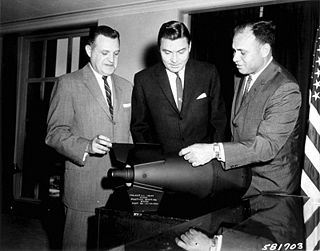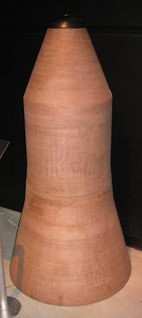
An intercontinental ballistic missile (ICBM) is a ballistic missile with a minimum range of 5,000 kilometres (3,100 mi) primarily designed for nuclear weapons delivery. Conventional, chemical, and biological weapons can also be delivered with varying effectiveness, but have never been deployed on ICBMs. Most modern designs support multiple independently targetable reentry vehicles (MIRVs), allowing a single missile to carry several warheads, each of which can strike a different target. Russia, the United States, China, France, India, the United Kingdom, and North Korea are the only countries known to have operational ICBMs; Israel is believed to possess them as well.
Lawrence Livermore National Laboratory (LLNL) is a federal research facility in Livermore, California, United States, founded by the University of California, Berkeley in 1952. Originally a branch of the Lawrence Berkeley National Laboratory, the Lawrence Livermore laboratory became autonomous in 1971 and was designated a national laboratory in 1981.

The LGM-30 Minuteman is an American land-based intercontinental ballistic missile (ICBM) in service with the Air Force Global Strike Command. As of 2021, the LGM-30G Minuteman III version is the only land-based ICBM in service in the United States and represents the land leg of the U.S. nuclear triad, along with the Trident submarine-launched ballistic missile (SLBM) and nuclear weapons carried by long-range strategic bombers.

Pakistan is one of nine states to possess nuclear weapons. Pakistan began development of nuclear weapons in January 1972 under Prime Minister Zulfikar Ali Bhutto, who delegated the program to the Chairman of the Pakistan Atomic Energy Commission (PAEC) Munir Ahmad Khan with a commitment to having the device ready by the end of 1976. Since PAEC, which consisted of over twenty laboratories and projects under reactor physicist Munir Ahmad Khan, was falling behind schedule and having considerable difficulty producing fissile material, Abdul Qadeer Khan, a metallurgist working on centrifuge enrichment for Urenco, joined the program at the behest of Bhutto administration by the end of 1974. As pointed out by Houston Wood, "The most difficult step in building a nuclear weapon is the production of fissile material"; as such, this work in producing fissile material as head of the Kahuta Project was pivotal to Pakistan developing the capability to detonate a nuclear bomb by the end of 1984.

As the collapse of the Soviet Union appeared imminent, the United States and their NATO allies grew concerned of the risk of nuclear weapons held in the Soviet republics falling into enemy hands. The Cooperative Threat Reduction (CTR) program was initiated by the Nunn–Lugar Act, which was authored and cosponsored by Sens. Sam Nunn (D-GA) and Richard Lugar (R-IN). According to the CTR website, the purpose of the CTR Program was originally "to secure and dismantle weapons of mass destruction and their associated infrastructure in former Soviet Union states." As the peace dividend grew old, an alternative 2009 explanation of the program was "to secure and dismantle weapons of mass destruction in states of the former Soviet Union and beyond". The CTR program funds have been disbursed since 1997 by the Defense Threat Reduction Agency (DTRA).

The W54 was a tactical nuclear warhead developed by the United States in the late 1950s. The weapon is notable for being the smallest nuclear weapon in both size and yield to have entered US service. It was a compact implosion device containing plutonium-239 as its fissile material, and in its various versions and mods it had a yield of 10 to 1,000 tons of TNT.

The W80 is a low to intermediate yield two-stage thermonuclear warhead deployed by the U.S. enduring stockpile with a variable yield ("dial-a-yield") of 5 or 150 kilotonnes of TNT.

The two-man rule is a control mechanism designed to achieve a high level of security for especially critical material or operations. Under this rule access and actions require the presence of two or more authorized people at all times.

Nuclear weapons delivery is the technology and systems used to place a nuclear weapon at the position of detonation, on or near its target. Several methods have been developed to carry out this task.
W70 was a two-stage, thermonuclear warhead that was developed for the MGM-52 Lance missile by the United States. Designed by Lawrence Livermore National Laboratory, the Mod 1 and Mod 2 version of the weapon entered service in 1973, while the enhanced radiation Mod 3 weapon entered service in 1981. The last W70 warhead was dismantled in February 1996.

Medium Atomic Demolition Munition (MADM) was a tactical nuclear weapon developed by the United States during the Cold War. It was an Atomic demolition munition, a combat engineering device for demolition of structures and for battlefield shaping. The device contained a W45 warhead with an estimated yield of 0.5 to 15 kilotonnes of TNT. Each MADM weighed 391 pounds (177 kg) in its transportation container. They were deployed between 1962 and 1986.

A tactical nuclear weapon (TNW) or non-strategic nuclear weapon (NSNW) is a nuclear weapon which is designed to be used on a battlefield in military situations, mostly with friendly forces in proximity and perhaps even on contested friendly territory. Generally smaller in explosive power, they are defined in contrast to strategic nuclear weapons, which are designed mostly to be targeted at the enemy interior away from the war front against military bases, cities, towns, arms industries, and other hardened or larger-area targets to damage the enemy's ability to wage war.

The W87 is an American thermonuclear missile warhead formerly deployed on the LGM-118A Peacekeeper ("MX") ICBM. 50 MX missiles were built, each carrying up to 10 W87 warheads in multiple independently targetable reentry vehicles, and were deployed from 1986 to 2005. Starting in 2007, 250 of the W87 warheads from retired Peacekeeper missiles were retrofitted onto much older Minuteman III missiles, with one warhead per missile.

The W84 is an American thermonuclear warhead initially designed for use on the BGM-109G Gryphon Ground Launched Cruise Missile (GLCM).

The W47 was an American thermonuclear warhead used on the Polaris A-1 sub-launched ballistic missile system. Various models were in service from 1960 through the end of 1974. The warhead was developed by the Lawrence Radiation Laboratory between 1957 and 1960.

The W59 was an American thermonuclear warhead used on some Minuteman I ICBM missiles from 1962 to 1969, and planned to be used on the cancelled GAM-87 Skybolt air-launched ballistic missile.

A nuclear triad is a three-pronged military force structure that consists of land-launched nuclear missiles, nuclear-missile-armed submarines, and strategic aircraft with nuclear bombs and missiles. Specifically, these components are land-based intercontinental ballistic missiles (ICBMs), submarine-launched ballistic missiles (SLBMs), and strategic bombers. The purpose of having this three-branched nuclear capability is to significantly reduce the possibility that an enemy could destroy all of a nation's nuclear forces in a first-strike attack. This, in turn, ensures a credible threat of a second strike, and thus increases a nation's nuclear deterrence.

A strong link/weak link and exclusion zone nuclear detonation mechanism is a type of safety mechanism employed in the arming and firing mechanisms of modern nuclear weapons.
The Strategic Missile Forces Museum in Ukraine is a military museum located near the town of Pobuzke (Побузьке) in Ukraine, about 250 kilometres (160 mi) south of Kyiv. It was built around the remains of a former underground Unified Command Post (UCP) for RT-23/SS-24 Molodets ICBM rockets.























